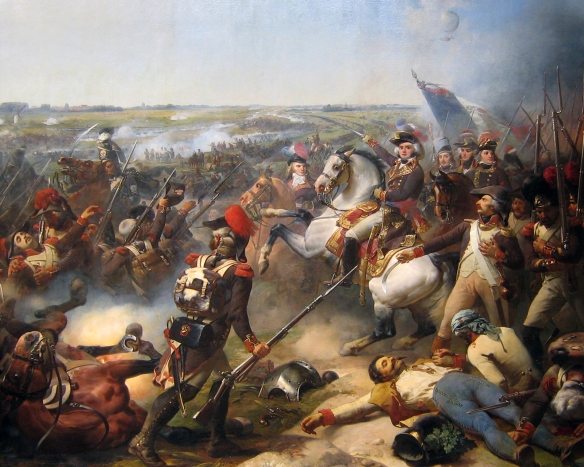Baron Paul Kray of Krajova and Topolya – he fought in Turkish war, promoted to general rank in 1790, fought at the battles of Amberg, Wurzburg, promoted to Feldmarschal-Leutnant in 1796. Defeated in 1797 at the battle of Neuwied. Also commanded in War of second coalition.
General Jean-Baptiste Jourdan
Indecisive Austrian victory over the French in northern Bavaria, east of Nuremburg. After the Battle of Rastatt, Archduke Charles had withdrawn eastward with Feldmarschalleutnant Maximillian Graf Baillet von Latour’s Army of the Upper Rhine, before fighting General Jean Moreau’s Army of the Rhine and Moselle to a standstill around Neresheim over 11-13 August. Charles’s daring strategy, utilizing the maneuver of the central position to achieve a local numerical superiority, was to march north to catch General Jean-Baptiste Jourdan’s Army of the Sambre and Meuse in a pincer movement with Feldzeugmeister Wilhelm Graf Wartensleben’s northern corps. After defeating this French army, he would move south again to cut Moreau’s links with France. Although the maneuver split the French armies, Jourdan narrowly escaped the trap and retreated west.
On 17 August, Charles left Latour and marched north with 28,000 men. In the north, Wartensleben had been driven 20 kilometers east of Amberg by Jourdan’s army, which had halted in the town. The archduke marched north on 22 August to attack General Bernadotte’s division around Neumarkt. After two days of fighting, Bernadotte withdrew northwest, leaving the road to Amberg open.
Aware of Bernadotte’s defeat, Jourdan was preparing to evacuate the town. To protect his heavy artillery, the 40,000 troops of the Sambre and Meuse army were positioned in a broad sweep in front of Amberg, with a reinforced right flank, since Jourdan expected Charles, with 18,000 men, to make the main attack. The Austrians had observed the withdrawal of the French guns, and Wartensleben realized that he had to pin Jourdan down to allow Charles time to arrive. During the afternoon of 23 August, he pushed four cavalry regiments across the Naab, followed by a general advance supported by heavy artillery. The French army initially held its ground, but around 11:00 P. M. began to retreat back toward Amberg.
Skirmishing continued through the night, and in the morning, Charles was driving General Jacques-Philippe Bonnaud’s French cavalry back through Kastel. To Jourdan’s surprise, the main Austrian assault broke from the east as Wartensleben’s 35,000 men advanced in three columns onto the hills above the town, which was divided by the Vils River. To the south were the divisions of generals Championnet and Paul Grenier, and to the east stood General Colaud’s division. Wartensleben’s first two columns (under Paul Kray Freiherr von Krajova and himself) overwhelmed Colaud and reached the southeastern part of Amberg; from there they opened up a heavy artillery bombardment. Meanwhile Generalmajor Karl Graf Hadik’s third column linked with Charles’s troops advancing from the Ursenulm wood on the south side. The battle became a rearguard action in the town as Jourdan hastened the retreat of the Sambre and Meuse army northwest to avoid being cut off by Generalmajor Johann Hotze’s column, which was pursuing Bernadotte toward the Nuremburg road. The last-minute French withdrawal had denied Charles a decisive victory, but Jourdan had lost 2,000 men against the Austrians’ 400 and would now withdraw westward toward Würzburg and away from Moreau.
References and further reading Charles, Archduke. 1816. Grundsätze der Strategie [Principles of Strategy].Vienna: Anton Strauss. Phipps, Ramsay Weston. 1980. The Armies of the First French Republic. Vol. 2, The Armées de la Moselle, du Rhin, de Sambre-et-Meuse, de Rhin-et-Moselle. London: Greenwood.
